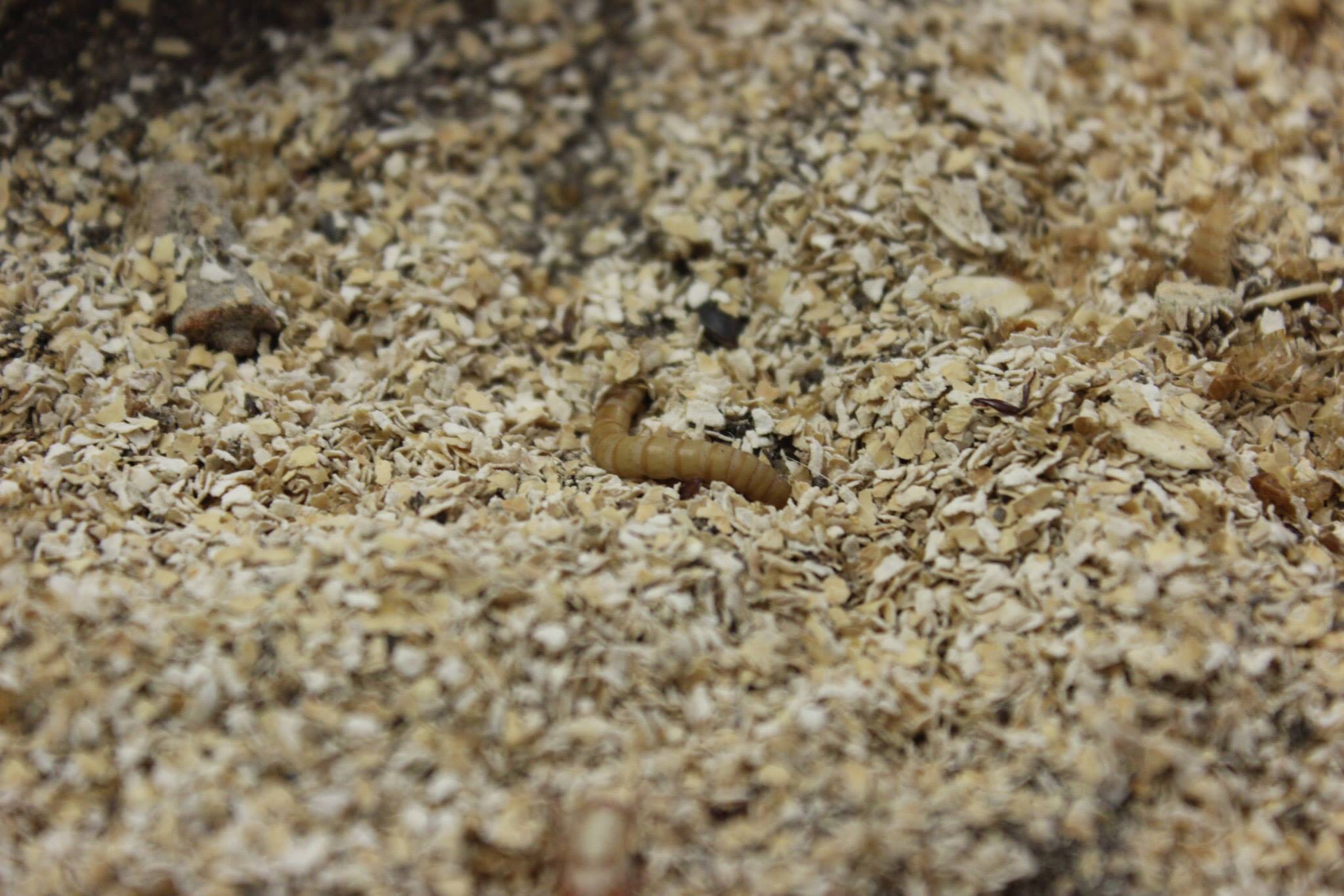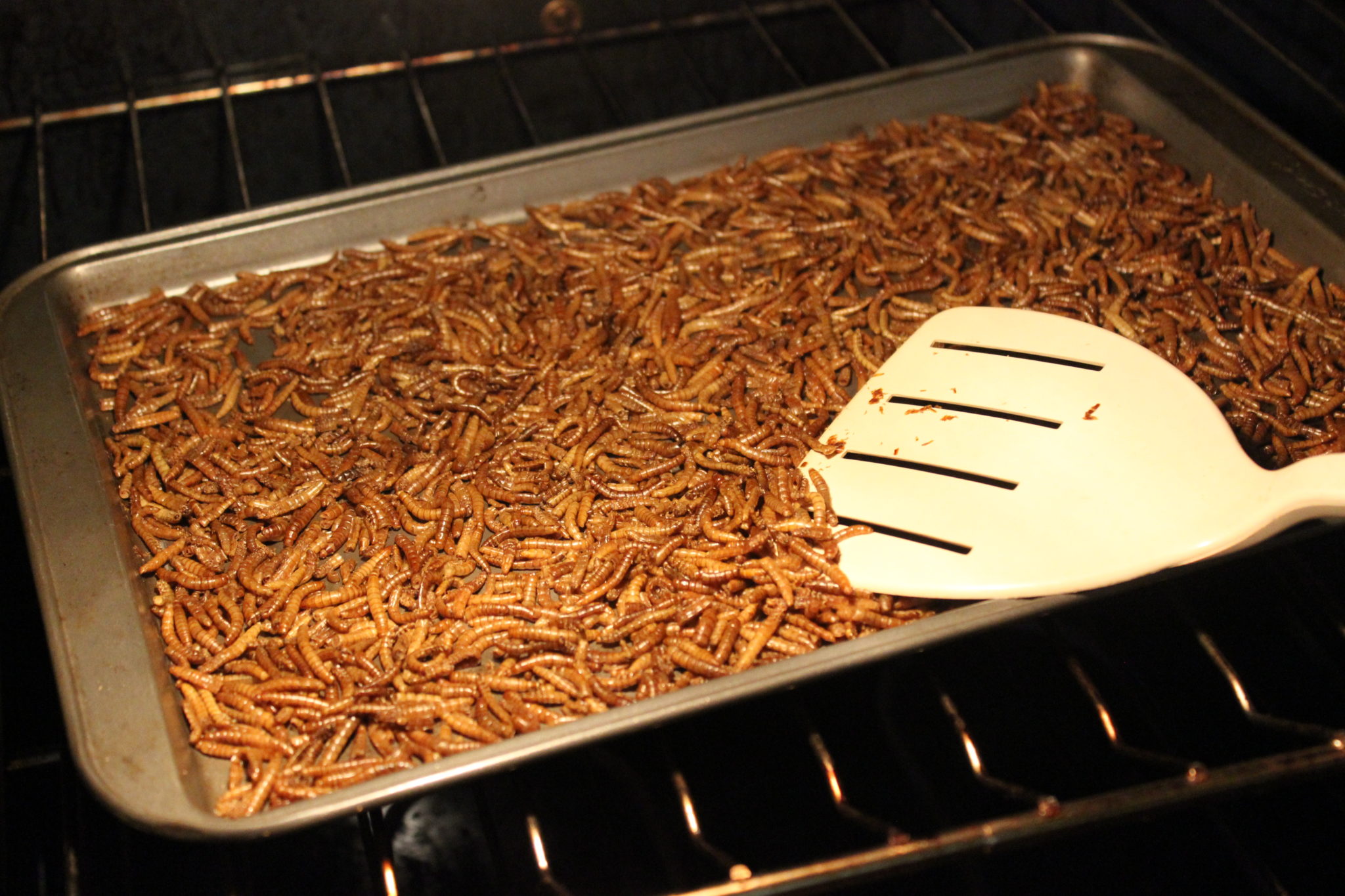How to start your own mealworm farm

Sometimes the best way to save a buck on feed is to make it yourself. A DIY mealworm farm is a cheap and easy way to make treats for your farm fowl from the comfort of your own home.
Mealworms are grub-like larvae of darkling beetles that are a protein-filled feed perfect for chickens. They are also used as feed for other domestic birds, reptiles, and fish.
Adventurous homesteaders can also grow mealworms to eat themselves.
Robert Nathan Allen, president and founder of the edible insect education non-profit Little Herds, describes the flavor of mealworms as “buttery, oaty, toasty, almost breakfast cereal-y.”
Allen recommends mealworms for first-time bug farmers instead of other popular critters like crickets. “Mealworms are a little less noisy,” he says. “Crickets chirp when they are at the age when they start reproducing.”
How to start a mealworm farm
Home-growing mealworm starter kits are available for purchase from several companies, but it is easy to put together your own. Start with a plastic tub: an 8 by 12 inches tub that’s no more than 6 inches deep should do the trick. If it has a lid, poke a few air holes, but if not, covering the open top with a fine wire mesh and sealing it with duct tape will do the trick. Mealworms aren’t the escape artists that crickets are, but like crickets, mealworms thrive in higher temperatures and humidities. A small humidifier and heat lamps to keep the space around a balmy 80 degrees.
“The great thing about mealworms is they don’t fly and don’t jump,” Allen says. “You can keep them in a cabinet, aquarium, closet, garage, or shed, as long as you’re keeping that temperature and humidity in a good range.”

You also need bedding, which will serve as a substrate for the mealworms to live in, breed in, and eat. Add a 2- or 3-inch layer of dry oats to the bottom of the bin for this purpose. Check the bedding frequently to prevent mold from working (mixing the oats with rice is a good way to remove excess moisture) and change it out every few weeks.
Once your micro-farm is ready, buy a couple hundred mealworms and add them to the container. Mealworms will lay eggs about one to two weeks into their adult lives, so if you treat the critters right, you will have a self-sustaining population with a new generation in no time. If you only plan on using the mealworms for chicken feed, you can purchase them at bait shops or pet stores, but any mealworms you plan to use in your culinary experiments should be sourced from farms that produce mealworms specifically for human consumption.
What do I feed mealworms?
Besides their oat substrate, mealworms munch on the scraps of potatoes, apples and carrots. Best of all, they do not need an additional water source; they use the moisture from their food.
When to harvest mealworms
After about a month, your first generation of mealworms will darken in color; in another week, they will morph into small black beetles. These beetles will lay eggs, which will hatch into light colored mealworms within a week or two. Freshly hatched mealworms are prime for harvesting, which can be done by hand, though the process is tedious. Shaking handfuls of mealworm-occupied bedding through a sifter will help separate the mealworms from the oats and frass, or insect poop, faster.
How to cook mealworms

For first-time mealworm chefs, Allen recommends tossing the harvested mealworms in some oil, spreading them out on a cookie sheet, and sprinkling them with spices.
Spice mixes like garlic parmesan chili lime and cinnamon sugar are some of his favorites. “The cinnamon sugar ones, if you do it right, taste like Cinnamon Toast Crunch,” Allen says. Roast the mix for an hour or two at two hundred degrees until golden brown. The result: a pub-grub style snack with the consistency of popped rice and a kick of flavor.
Mealworm cuisine is an adventurous experiment, though some still squirm at the thought of eating worms. Even if you don’t plan to add mealworms to your diet, your chickens will thank you for the locally-sourced treats.

Hi Sam,
About 3 weeks ago ? I purchased some meal worms in order to start breeding my own and I have had some become pupa then beetles which was lovely but no matter what I feed them for moisture they wont eat it. I have tried carrot ( some organic, some regular ones ), apple, cucumber, and potato. I have feed these foods to the worms and the beetles but no joy. What should I do ? They have oats, oat bran and wheat bran as the bedding and they do eat this but I am so concerned that they are not getting anything with moisture in it . I have watched many u tube videos of meal worm farming and their little critters devour the food they give them. Please can you advise me on what to do ?
Thank you.
Alison.
Hi, Alison! I asked some experts, and they said that the conditions may not be moist and warm enough to encourage the beetles to eat. Some mealworm farmers have had better luck with sliced radishes for darkling beetles, but in general, the beetles eat a lot less than the larvae. If the larvae are pupating then they are probably fine, just keep an eye out to make sure your critters aren’t dying in large quantities. Hope this helps!
Thank you for your post! I am a teacher and I am going to start my own mealworm farm in the next couple days.
I had a student put medicated chick starter in with the bedding that we set up. Do I need to throw the whole batch of bedding away, or will they be ok with the medicated food in there? There is also oatmeal and cornmeal in my bedding. The chick starter makes up about 1/3 of the bedding.
Thanks for any thoughts on the matter!
Hi Emily, thanks for your great question! I consulted with the wonderful Robert Nathan Allen at Little Herds, and he said that if you’re planning to eat them, you should probably not be using anything medicated. He recommends throwing out the bedding and raising them until they’ve grown a completely new generation before eating them, just to be on the safe side. Good luck with your mealworms!
Thank you for the information. Am ephline from Kenya was asking where I can buy starter worms to raise.please help.
[…] for sale: Apparently, you just need oatmeal and a strong stomach . Not sure why, but these creep me out way more than compost […]
Hi Sam,
I have purchased meal worms days ago. My question is about their food. What are their basic foods except vegetable? Please can you advise me on what to do ?
Thank you.
Qahraman.
I started a mealworm “farm” using a three drawer bin and followed instructions. I’m taking good care of them with food, separating pupa from worms, etc. I have plenty of moist food without too much. When I started this, the instructions said 3 drawers, one for worms, one for pupa and one for the eggs to fall into when the beetles lay them. So, the pupa go into a drawer and become beetles and then the beetles lay eggs. I just read that the beetles will eat the pupa so now, I’m thinking that the pupa need to stay in the drawer with the worms until they become beetles to then put them in the drawer in which to lay eggs (has screen in the bottom of the drawer for the eggs to fall through). I have food in all three drawers but have seen no babies. Some of my pupa have died and some of my beetles have died. Not sure why unless the beetles were old enough to die but I don’t think so. Can someone advise me about whether or not I’m doing this correctly or how to do this, please.
Thanks for your question, Claudia. I reached out to our expert at Little Herds and he said both the beetles and the larvae will munch on the pupae if given the opportunity and hungry. He recommended keeping the critters separated at every stage of their development.
He also had this tip: turn a coffee mug upside down and place it in your beetle substrate, then put your pupae that are about to emerge into beetles on top. Once they finish turning into beetles, they just fall off the side of the cup into the substrate and can’t get back to the pupae.
we started a meal worm farm and we have beetles on beetles but see no new worms help